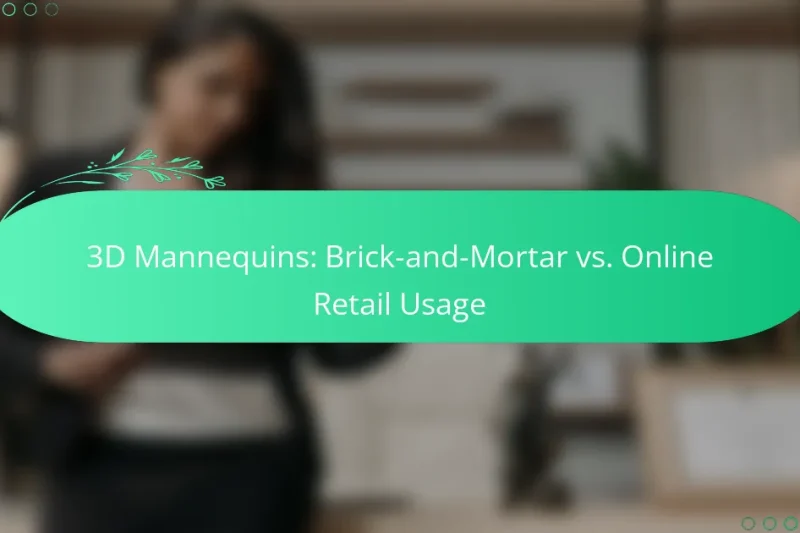3D mannequins play a crucial role in enhancing seasonal promotions by delivering visually captivating displays that … 3D Mannequins: Seasonal Promotions, Adaptability and Marketing StrategiesRead more
3D Mannequin Usage Scenarios
3D mannequins are revolutionizing the retail landscape by enhancing customer experiences and optimizing product displays. These digital representations allow shoppers to visualize items in a more interactive and realistic manner, ultimately leading to better purchasing decisions. Additionally, they serve as valuable tools for online retailers, boosting engagement and sales performance through lifelike product presentations.
3D Mannequins: User Feedback, Retail Environment Insights and Experience
3D mannequins are revolutionizing retail environments by offering an engaging and interactive way to display products, … 3D Mannequins: User Feedback, Retail Environment Insights and ExperienceRead more
3D Mannequins: Pop-Up Shop Strategies, Customer Engagement and Visual Merchandising
3D mannequins are revolutionizing pop-up shop strategies by offering dynamic and interactive displays that captivate customers … 3D Mannequins: Pop-Up Shop Strategies, Customer Engagement and Visual MerchandisingRead more
3D Mannequins: Case Studies, Retail Success and Customer Experience
3D mannequins are revolutionizing the retail landscape by creating immersive and interactive shopping experiences that captivate … 3D Mannequins: Case Studies, Retail Success and Customer ExperienceRead more
3D Mannequins: Brick-and-Mortar vs. Online Retail Usage
3D mannequins play a crucial role in both brick-and-mortar and online retail, enhancing the shopping experience … 3D Mannequins: Brick-and-Mortar vs. Online Retail UsageRead more
3D Mannequins: Trade Show Impact, Brand Visibility and Customer Interaction
3D mannequins play a crucial role in enhancing trade show impact by providing a visually captivating … 3D Mannequins: Trade Show Impact, Brand Visibility and Customer InteractionRead more
What are the primary usage scenarios for 3D mannequins in retail?
3D mannequins are primarily used in retail for enhancing customer experience, showcasing products, and streamlining operations. These digital tools enable retailers to create immersive environments that facilitate better shopping decisions and improve inventory management.
Virtual fitting rooms
Virtual fitting rooms allow customers to try on clothes digitally using 3D mannequins. This technology enhances the shopping experience by enabling users to visualize how garments will fit and look without physically trying them on. Retailers can increase conversion rates by offering this feature, as it reduces the uncertainty associated with online shopping.
To implement virtual fitting rooms, retailers should ensure that the 3D models accurately represent their clothing sizes and styles. Regular updates and user-friendly interfaces can significantly enhance customer satisfaction.
Product displays
3D mannequins serve as dynamic product displays that can showcase clothing and accessories in an engaging manner. By using realistic representations, retailers can highlight the fit and style of their products, making them more appealing to customers. This approach can lead to increased foot traffic and sales.
Consider using 3D mannequins in window displays or online catalogs to attract attention. Ensure that the lighting and background complement the products to maximize visual impact.
Fashion shows
In fashion shows, 3D mannequins can simulate runway presentations, allowing designers to showcase their collections without the logistical challenges of live models. This method can save time and resources while still delivering a captivating visual experience to audiences.
Utilizing 3D mannequins in virtual fashion shows can also reach a broader audience through online streaming. Retailers should invest in high-quality animations and realistic movements to enhance the overall presentation.
Interactive marketing
Interactive marketing campaigns can leverage 3D mannequins to engage customers in unique ways. By allowing users to customize outfits on virtual mannequins, retailers can create a personalized shopping experience that encourages interaction and sharing on social media.
To maximize effectiveness, retailers should integrate these interactive elements into their websites and mobile apps, ensuring they are easy to use and visually appealing. Promotions or contests can further incentivize participation.
Inventory management
3D mannequins can assist in inventory management by providing accurate visual representations of stock levels and product placements. Retailers can use these models to simulate store layouts and optimize product placement for better visibility and accessibility.
Implementing a system that tracks inventory in real-time alongside 3D mannequins can help retailers make informed decisions about restocking and product promotions. Regular audits and updates to the 3D models can enhance accuracy and efficiency in inventory management.
How do 3D mannequins enhance customer experience?
3D mannequins significantly enhance customer experience by providing a more immersive and interactive shopping environment. They allow customers to visualize products in a realistic manner, leading to informed purchasing decisions and increased satisfaction.
Personalized shopping experiences
3D mannequins can be tailored to reflect individual customer preferences, creating a unique shopping experience. For instance, retailers can adjust the mannequin’s appearance to showcase clothing styles that align with a customer’s past purchases or browsing history.
This personalization can be achieved through data analytics and customer profiles, allowing stores to recommend outfits that fit specific body types or fashion tastes. Such targeted experiences can lead to higher conversion rates and customer loyalty.
Increased engagement through interactivity
Interactive 3D mannequins engage customers by allowing them to manipulate the display, such as changing colors or styles in real-time. This hands-on approach keeps customers interested and encourages them to spend more time exploring products.
For example, a customer might use a touchscreen to customize a mannequin’s outfit, which can lead to a more memorable shopping experience. Retailers should consider integrating these interactive features to boost customer interaction and drive sales.
What are the benefits of using 3D mannequins for online retailers?
3D mannequins offer several advantages for online retailers, including enhanced customer engagement and improved sales performance. By providing a realistic representation of products, they help shoppers make informed purchasing decisions.
Improved conversion rates
Utilizing 3D mannequins can significantly boost conversion rates for online retailers. When customers can visualize how a product looks on a realistic model, they are more likely to complete a purchase. Studies suggest that conversion rates can increase by 20-30% when 3D visualizations are used effectively.
To maximize this benefit, ensure that the 3D models are high-quality and accurately represent the product. Incorporating interactive features, such as the ability to rotate the mannequin, can further enhance user experience and drive sales.
Reduced return rates
3D mannequins help in reducing return rates by providing customers with a clearer understanding of product fit and appearance. When shoppers can see how clothing looks on a 3D model, they are less likely to make purchases that do not meet their expectations.
Retailers should consider including detailed size guides alongside 3D visuals to further minimize returns. This combination allows customers to make more informed choices, potentially reducing return rates by 15-25%.
Enhanced product visualization
3D mannequins enhance product visualization by allowing customers to view items from multiple angles and in various settings. This immersive experience helps shoppers better understand the product’s features and how it fits into their lifestyle.
To leverage this advantage, retailers should invest in high-quality 3D rendering technology and consider offering customization options, such as changing colors or styles on the mannequin. This level of interactivity can significantly improve customer satisfaction and engagement.
What factors should retailers consider when choosing 3D mannequins?
Retailers should consider several key factors when selecting 3D mannequins, including their target audience, technology integration, and budget constraints. These elements will significantly influence the effectiveness and return on investment of the mannequins in enhancing customer engagement and sales.
Target audience demographics
Understanding the target audience demographics is crucial for retailers when choosing 3D mannequins. Different age groups, gender preferences, and cultural backgrounds may respond differently to visual merchandising. For instance, a fashion retailer targeting young adults may opt for dynamic, trendy designs, while a store aimed at older customers might prefer classic and elegant representations.
Retailers should analyze customer data to identify the preferences and behaviors of their audience. This can guide the choice of mannequin styles, poses, and even the types of clothing displayed, ensuring alignment with customer expectations and enhancing the shopping experience.
Integration with existing technology
Seamless integration with existing technology is essential for maximizing the utility of 3D mannequins. Retailers should assess how these mannequins will work with their current systems, such as inventory management, point of sale, and digital displays. For example, mannequins that can connect to digital signage can provide real-time updates on promotions or stock levels.
Consideration of software compatibility is also important. Retailers should ensure that the 3D mannequins can easily interface with their existing platforms to streamline operations and enhance customer interaction. This may involve checking for APIs or other integration tools that facilitate communication between systems.
Budget constraints
Budget constraints play a significant role in the selection of 3D mannequins. Retailers need to evaluate the total cost of ownership, which includes not only the initial purchase price but also maintenance, software updates, and potential training for staff. Setting a clear budget can help narrow down options and prevent overspending.
It is advisable to compare different suppliers and models to find the best value. Retailers should also consider the long-term benefits of investing in higher-quality mannequins that may offer better durability and features, potentially leading to lower costs over time. A well-planned budget can ensure that the investment in 3D mannequins aligns with overall business goals and financial capabilities.
How can 3D mannequins be utilized in fashion design?
3D mannequins serve as essential tools in fashion design, allowing designers to create, visualize, and test their garments in a virtual environment. They facilitate a more efficient design process by enabling rapid prototyping and realistic presentations of clothing concepts.
Prototype testing
Using 3D mannequins for prototype testing allows designers to assess fit, movement, and overall aesthetics before producing physical samples. This method can significantly reduce material waste and production costs, as adjustments can be made digitally. Designers can simulate various body types and sizes, ensuring a broader market appeal.
To effectively utilize 3D mannequins for prototype testing, designers should focus on key aspects such as fabric drape, color matching, and design details. Regularly updating the mannequin library to include diverse body shapes can enhance inclusivity and customer satisfaction.
Design visualization
3D mannequins enhance design visualization by providing realistic representations of garments in a digital format. This capability allows designers to showcase their work in marketing materials, online platforms, and presentations without the need for physical samples. High-quality renderings can attract potential buyers and investors by highlighting the garment’s features effectively.
For optimal design visualization, consider using advanced rendering software that supports realistic textures and lighting effects. Regularly updating visual assets can keep the brand fresh and appealing to consumers, ensuring that the designs resonate with current trends and preferences.
What are the emerging trends in 3D mannequin technology?
Emerging trends in 3D mannequin technology include enhanced realism, customization options, and integration with digital platforms. These advancements are reshaping how businesses showcase products, allowing for more interactive and engaging customer experiences.
Augmented reality integration
Augmented reality (AR) integration allows customers to visualize 3D mannequins in their own environments using smartphones or AR glasses. This technology enhances the shopping experience by enabling users to see how clothing fits and looks in real-time without needing to visit a physical store.
To effectively implement AR with 3D mannequins, businesses should consider user-friendly applications that provide seamless interaction. For example, retailers can create AR features in their mobile apps that allow customers to place a virtual mannequin in their living space, helping them make informed purchasing decisions.
When adopting AR technology, ensure that the 3D models are high-quality and accurately represent the products. Common pitfalls include using low-resolution graphics or complex interfaces that can frustrate users. Focus on simplicity and clarity to maximize engagement and satisfaction.





